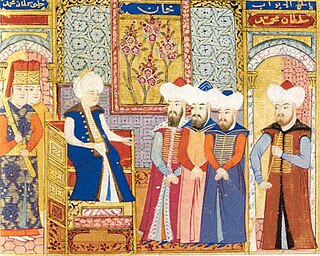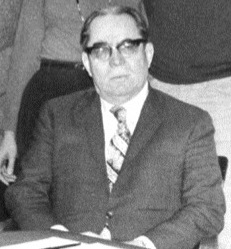
Mehmed I, also known as Mehmed Çelebi or Kirişçi, was the sultan of the Ottoman Empire from 1413 to 1421. Son of Sultan Bayezid I and his concubine Devlet Hatun, he fought with his brothers over control of the Ottoman realm in the Ottoman Interregnum (1402–1413). Starting from the province of Rûm he managed to bring first Anatolia and then the European territories (Rumelia) under his control, reuniting the Ottoman state by 1413, and ruling it until his death in 1421. Called "The Restorer," he reestablished central authority in Anatolia, and he expanded the Ottoman presence in Europe by the conquest of Wallachia in 1415. Venice destroyed his fleet off Gallipoli in 1416 as the Ottomans lost a naval war.

Ertuğrul or Ertuğrul Ghazi was a 13th-century bey, who was the father of Osman I. Little is known about Ertuğrul's life. According to Ottoman tradition, he was the son of Suleyman Shah, the leader of the Kayı tribe of the Oghuz Turks. These Turkomans fled from western Central Asia to Anatolia to escape the Mongol conquests, but he may instead have been the son of Gündüz Alp. According to this legend, after the death of his father, Ertuğrul and his followers entered the service of the Sultanate of Rum, for which he was rewarded with dominion over the town of Söğüt on the frontier with the Byzantine Empire. This set off the chain of events that would ultimately lead to the founding of the Ottoman Empire.

Zaganos or Zagan Pasha was an Albanian Ottoman military commander, with the titles and ranks of kapudan pasha and the highest military rank, grand vizier, during the reign of Sultan Mehmed II "the Conqueror". Originally a Christian, who was conscripted and converted through the devşirme system, he became a Muslim and rose through the ranks of the janissaries. He became one of the prominent military commanders of Mehmed II and a lala – the sultan's advisor, mentor, tutor, councillor, protector, all at once. He removed his rival, the previous Grand Vizier Çandarlı Halil Pasha the Younger, amid the fall of Constantinople. He later served as the governor of Thessaly of Macedonia.
Suleyman Shah was, according to Ottoman tradition, the son of Kaya Alp and the father of Ertuğrul, who was the father of Osman I, the founder of the Ottoman Empire. Early Ottoman genealogies disputed this lineage, and either Suleyman Shah or Gündüz Alp could be Osman's grandfather and the father of Ertuğrul. An Ottoman tomb initially in or near Qal'at Ja'bar has historically been associated with Suleyman Shah. He succeeded his father as bey in 1214 when he decided to lead the 50,000 strong tribe West in the face of Mongol invasion. After migrating to the North Caucasus, thousands of Kayis settled in Erzincan and Ahlat in 1214, while some of the other Kayi groups dispersed in Diyarbakir, Mardin, and Urfa.

Halil İnalcık was a Turkish historian. His highly influential research centered on social and economic approaches to the Ottoman Empire. His academic career started at Ankara University, where he completed his PhD and worked between 1940 and 1972. Between 1972 and 1986 he taught Ottoman history at the University of Chicago. From 1994 on he taught at Bilkent University, where he founded the history department. He was a founding member of the Eurasian Academy.

Mustafa Abdülhalik Renda was a Turkish civil servant and politician of Tosk Albanian descent who was acting President of Turkey for one day after Atatürk's death in November 1938. He is infamously known for his role in the Armenian genocide.

Khalil Sherif Pasha, transliterated variously as Halil Şerif Pasha, was an Ottoman-Egyptian statesman, diplomat and art collector, who lived during the Tanzimat period. His collection was described by Théophile Gautier as "the first ever to be formed by a child of Islam". He was furthermore involved in diplomatic affairs following the aftermath of the Crimean War. He also served as the Ottoman Minister of Foreign Affairs.
Halil Pasha was an Ottoman statesman who served as the governor of Ottoman Egypt from 1631 to 1633. He was known for his "gentle, impartial, and prosperous administration" which was in large contrast to the "rapacious" administration of his predecessor, Koca Musa Pasha. In Shawwal 1041 AH, while governor, he sent an expeditionary force to the Hejaz to retake Mecca from Yemeni troops who had seized the city in the name of a pretender to the Sharifate.
Ibrahim II was a bey of Karaman.

Mustafa Çelebi, also called Mustafa the Impostor, was an Ottoman prince who struggled to gain the throne of the Ottoman Empire in the early 15th century. He was the Sultan of Rumelia twice during January 1419 – 1420 and January 1421 – May 1422.
Halil Bey (1347–1362) was an Ottoman prince. His father was Orhan, the second bey of the Ottoman beylik. His mother was Theodora Kantakouzene, the daughter of Byzantine emperor John VI Kantakouzenos and Irene Asanina. His kidnapping was an important event in 14th century Ottoman-Byzantine relations. He was killed by his brother Murad I.
The House of Taushani was an Albanian aristocratic family prominent from the 15th to 19th century. According to prof. Stavri Naci, the most powerful families of Albania that played an important economic and political role were, "in Shkoder, the Bushati and Caushollaj; in Peja, Begollaj; in Elbasan, Taushani and Bicaku; in Vlora, Velabishtaj and Vlora; in Delvina, Kapllanpashalli; in Kruja, Toptani; and in Kavaja, the Alltuni."
İlyas Bey was the second bey (lord) of the Turkish beylik of Saruhan in the 14th century.
Ibrahim I was a bey of the Karamanids, a Turkoman principality in Anatolia in the 14th century.
Alaattin Ali of Karaman (d.1397), also Alaeddin Ali, was a bey of Karaman Beylik, a Turkish principality in Anatolia in the 14th century. Like most other Karaman beys, Ali Bey was a rival of the rising Ottoman Empire, and the two principalities engaged in chronic wars against one another.
Süleyman of Karaman was a bey of the Karaman Beylik, a Turkish principality in Anatolia in the 14th century.
Alaeddin Pasha was the first Ottoman grand vizier. His father's name was Kemaleddin, and thus he was usually called Hacı Kemaleddin oğlu Alaeddin Pasha or Alaeddin bin Hacı Kemaleddin, meaning "son of Hacı Kemaleddin" He was probably from the town of Cendere, from where the famous Çandarlı family also originated. He was a faqih. He was appointed as the vizier during the last years of Osman I's reign. He continued during Orhan's Bey's reign. Since there was only one vizier in the divan during the early years of the Ottoman beylik, his title was not actually grand vizier, but his post was equivalent to the post of the later grand viziers. Because of this, he is known as the first grand vizier of the Ottoman Empire.
Konstantinos Kolokotronis was a notable Greek klepht leader in the third quarter of the 18th century in the Peloponnese, and the father of Theodoros Kolokotronis, one of the leaders of the Greek War of Independence.

Gündüz Alp was the likely father of Ertuğrul and grandfather of Osman I, the founder of the Ottoman Dynasty. According to some sources, the name of one of the sons of Ertuğrul was also Gündüz Alp, and thus the brother of Osman I. Ottoman histories, written around the 15th century, differ in details about Osman I's ancestry.

The Halil Bey Mosque is a historical Ottoman-era mosque in the town of Kavala, Eastern Macedonia and Thrace, in Greece. It is now a museum open to visitors.










